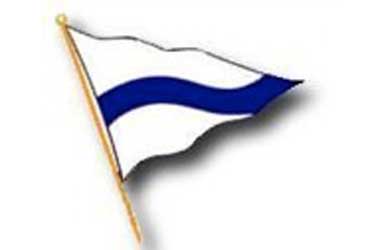
Cruising Club of America
Thies Matzen and Kicki Ericson Presented with the 2011 Blue Water Medal
The Cruising Club of America (CCA) has awarded its esteemed 2011 Blue Water Medal to Thies Matzen and Kicki Ericson for a commendable 24 years and 135,000 miles of sailing the oceans of the world with a focus in the high latitudes of the Southern Ocean. The first Blue Water Medal was awarded in 1923; and is given to “the most meritous example of seamanship.” Its recipient is selected from among amateurs of all the nations.” The medal will be presented by Commodore Daniel P. Dyer, III at the annual Awards Dinner on March 2, 2012 at New York Yacht Club in Manhattan.
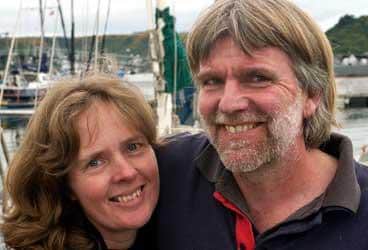
Matzen was born in Germany in 1956 and grew up to be a wooden boat builder. In 1981, Matzen purchased Wanderer III, a 30 foot wooden sloop, built in 1952 for Eric and Susan Hiscock who made two circumnavigations with it and received the Blue Water Medal in 1955. Matzen sailed Wanderer III to Scandinavia where he cruised extensively, including to the Lofoten Islands (Norway), and then crossed the Atlantic Ocean. In 1989, while sailing in the Caribbean, he met Swedish-born (1964) Ericson, and the two have lived on Wanderer III ever since. After leaving the Caribbean, the duo sailed through the Panama Canal and into the Pacific Ocean where they spent seven years traveling from site to site. After that, Ericson and Matzen sailed to Indonesia, explored the Indian Ocean, and sailed around the Cape of Good Hope (South Africa).
From 1997 to 1999, Matzen and Ericson did two circuits of the South Atlantic, starting in Cape Town (South Africa) and visiting Argentina, The Falkland Islands, and South Georgia before heading back to Cape Town (South Africa) and South America, where they rounded Cape Horn before returning to the Pacific. The couple’s last 12 years have been comprised of exploring sites in the Southern Ocean, including Tasmania, The Auckland Islands, Antarctica and the Falkland Islands. Recently the two spent 26 months in South Georgia. Currently, Matzen and Ericson are in Brazil and plan to do some work on_ Wanderer III_, which has been kept in its original condition with no electronics onboard except a VHF radio and handheld GPS (added in 2007). The vessel has a 16 horsepower diesel engine and the hull, rigging, and gear have been self-maintained using traditional methods.
Gary Jobson Honored with CCA’s 2011 Richard S. Nye Trophy
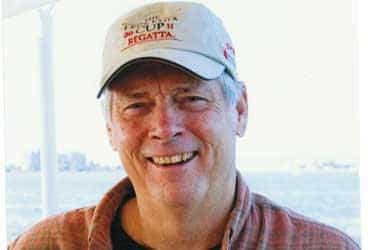
The Cruising Club of America (CCA) has selected Gary Jobson (Annapolis, Md.) to receive its Richard S. Nye Trophy for sharing with the club his meritorious service, racing, and statesmanship in the affairs of international yachting. The trophy will be awarded by Commodore Daniel P. Dyer, III at the annual Awards Dinner on March 2, 2012 at New York Yacht Club in Manhattan.
Jobson, who graduated from SUNY Maritime (Throgs Neck, N.Y.) in 1973 as an Inter-Collegiate Sailing All-American and two-time College Sailor of the Year, started his career as a sailing coach for the U.S. Merchant Marine Academy and the U.S. Naval Academy. Dating back to 1967, Jobson has competed in 5,400 sailboat races, including the 1977 America’s Cup, where he served as tactician for Ted Turner aboard the winning 12 Metre Courageous; eight Bermuda Races; six transatlantic races, and five Fastnet races. Jobson also has completed 17 cruises with his wife Janice and three daughters Brooke, Ashleigh, and Kristi. Currently, Jobson is President of US Sailing, the National Governing Body of Sailing, and acts as Editor at Large of Sailing World and Cruising World magazines.
With so much background in racing and cruising, Jobson’s transition into other areas of the sailing industry was inevitable. In 2003, while sick with Leukemia, Jobson began penning a memoir about the sport of sailing being a determining factor in his recovery. It was later published as Gary Jobson: An American Sailing Story and added yet another book to the 17 he has written. And if that would not be enough on anyone’s resume, since 1973, Jobson has given 2,400 lectures, and in 2011 he broke his lectures-given-per-year record by completing 124 presentations at yacht clubs and sailing organizations around the country. He also has produced or narrated roughly 800 television shows; has covered the America’s Cup eight times; and will count 2012 as his sixth Olympic Games, where in 1988 he won an Emmy for his production of the sailing event coverage for NBC.
Over the years, Jobson has won numerous awards for his generous work in promoting the sport of sailing, including the 1999 Nathaniel G. Herreshoff Trophy, US Sailing’s most prestigious award, given for an outstanding contribution to the sport of sailing in the United States. One of his finest achievements has been as National Chairman of the Leukemia Cup and the Leukemia & Lymphoma Society’s sailing program, which has raised approximately $40 million within the sailing communities.
Brian and Mary Alice O’Neill presented the 2011 Far Horizons Award
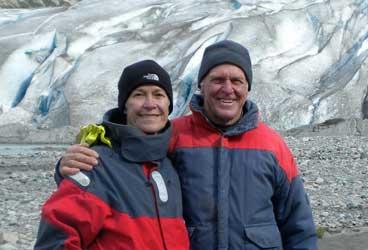
The Cruising Club of America (CCA) has selected Brian and Mary Alice O’Neill (Bainbridge Island, WA) to receive its Far Horizons Award for an admirable 25-month cruise circumnavigating the Pacific Rim, North Pacific Ocean. En route the two delivered school supplies to those in need and toured WWII sites. The award is given to a member of CCA “for a particularly meritorious cruise or series of cruises that exemplify the objectives of the Club.” The award will be presented by Commodore Daniel P. Dyer, III at the annual Awards Dinner on March 2, 2012 at New York Yacht Club in Manhattan.
The two met in Japan in 1977. Brian, a Marine Corps Aviator, taught Mary Alice, then a kindergarten teacher, how to sail. In 1978, they were married and quenched their thirst for the sea with many cruises over the years. In 1987, the couple sailed to New Zealand and sold their boat upon arrival in Auckland. In 1992, the couple bought Shibui, a 44-foot Robert Perry designed sloop, and began a 5-year circumnavigation of the world.
The CCA is honoring them for their most notable journey in 2009 when the O’Neill’s, put their three passions – Military history, education, and sailing – to work and embarked on a new adventure. Their goal was to visit many of the WWII Pacific Ocean sites and help out island schools along the way. They filled Shibui to the brim with schoolbooks and supplies and departed from their home in Bainbridge in August 2009. The first stop was Hawaii where, for all intents and purposes, the war in the Pacific began. From Hawaii, the O’Neill’s traveled 1,000 miles south to the Palmyra Atoll (U.S. territory), which was the site of a large WWII airbase protecting the southern flank of the Hawaiian Islands. It is now owned by The Nature Conservancy and used for environmental research.
From there, the couple sailed to the island of Maloleop (Republic of the Marshall Islands), home to a WWII Japanese airbase, where they visited the school and delivered school supplies. Continuing westward, the two visited Kwajalein Atoll (Republic of the Marshall Islands), used presently as a U.S. missile tracking station, and continued westward to the Federated States of Micronesia (FSM) where they visited schools on the islands and explored former Japanese military installations. When the O’Neills visited Lamotrek (Yap State, FSM), an island with a population of approximately 350, Mary Alice worked at the small school while Brian worked as a handyman.
After 10 months of cruising, the two arrived in the Republic of Palau in May 2010. They spent the next seven months exploring the island nation. Peleliu, a state in Palau, was the site of a horrific battle, known as the Battle of Peleliu. The battle resulted in approximately 20,000 U.S. and Japanese casualties on the beaches and in caves on the island. Now with a population of 400, Peleliu still shows the scars from over 50 years ago with weapons and unexploded ordnance littering the jungle and surrounding ocean.
To avoid the typhoon season, in December the O’Neills next voyaged west to the Philippines and north to Japan. They explored many of these country’s islands, including Okinawa, well known for the Battle of Okinawa in 1945, leading to the end of WWII. Upon leaving Japan, the O’Neill’s sailed northeast to Adak, Alaska, the site of a WWII U.S. military base, and across the Bering Sea, stopping in Dutch Harbor, Kodiak Island, Lituya, and Glacier Bay. In September 2011, after two years at sea, the O’Neill’s arrived back in Bainbridge Island and look forward to future voyages.
**Bob Arzbaecher and the crew of Sociable are presented the 2011 Rod Stephens Trophy
**
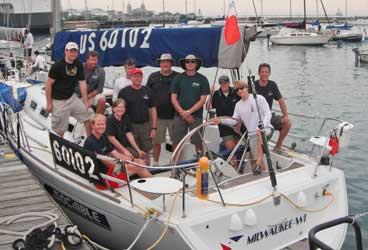
The Cruising Club of America’s (CCA) 2011 Rod Stephens Trophy for Outstanding Seamanship is well deserved by Bob Arzbaecher (Milwaukee, Wisc.) and the crew of the Beneteau 40.7 Sociable for their dramatic rescue of the crew of the Kiwi 35 WingNuts during the Chicago Yacht Club’s 103rd Race to Mackinac held this past July. The trophy is given “for an act of seamanship which significantly contributes to the safety of a yacht, or one or more individuals at sea” and will be awarded by Commodore Daniel P. Dyer, III at the annual Awards Dinner, March 2, 2012, at the New York Yacht Club in Manhattan.
Arzbaecher has been sailing for ten years with the Sociable crew, many of whom have competed in the Chicago-Mackinac and other long distance races on Lake Michigan. This year, his crew consisted of 11 sailors: Greg Adams, Cathy Patrick, Chris Miotke, Brian Adams, Matt Reising, Dave Patrick, Brian Nagle, Amy Marshall, Pete Duecker, Adam Flanders (all Milwaukee, Wisc.)and Matt Younkle (Madison, Wisc.).
The team’s life-altering moment took place at 11 p.m. on Sunday, July 17, 2011, when a severe squall tore through the fleet of 361 racing sailboats 30 hours into the 333-mile offshore race. After the storm had passed and the sailors aboard Sociable had re-hoisted the mainsail, they heard a whistle in the distance. Shortly afterward, in the black of night, a faint light appeared to port, approximately a quarter to one-half mile away.
Without hesitation, the crew tacked Sociable in the direction of the light and turned on flashlights to signal their presence, which was returned with more light flashes. After lowering the main and powering up the engine, the Sociable crew headed in the direction of the unknown vessel, and as they approached realized that it was upside down with several people standing on its bottom. Though the squall had passed, the conditions were still rough, with three-to-five foot waves and winds upwards of 20 knots. Sociable used its radio to contact the Coast Guard, and as they came within hailing distance of WingNuts they counted five crewmembers on the boat and one in the water, clinging to the side.
Sociable deployed a Lifesling and circled WingNuts, trying to avoid the mass of lines tangled in the water. The team first managed to retrieve the man overboard, and then continued to circle the overturned boat and retrieve the remaining crewmembers, who took turns jumping into the water and grabbing hold of the Lifesling. In 10 minutes, the WingNuts crew – minus two who were missing – had been brought aboard, taken below and given blankets. Sociable continued looking for the missing crewmembers, but when the Coast Guard arrived with a helicopter and rescue boat, it departed for Charlevoix, Mich., the closest port, and dropped off the WingNuts crew at the Coast Guard station, where ambulances awaited.
“Bob Arzbaecher and his crew of Sociable are to be congratulated for their organization and preparedness in executing the rescue of six sailors,” said Commodore Dyer. “But the world will continue to mourn the loss of the two crew – Suzanne Makowski Bickel and Mark Morely – who perished that night.”
_About the Cruising Club of America
The Cruising Club of America is dedicated to offshore cruising, voyaging and the “adventurous use of the sea” through efforts to improve seamanship, the design of seaworthy yachts, safe yachting procedures and environmental awareness. Now in its 90th year, the club has 11 stations throughout the U.S., Canada and Bermuda, with approximately 1200 members who are qualified by their experience in offshore passage making. In even-numbered years, the CCA organizes the Newport to Bermuda Race in conjunction with the Royal Bermuda Yacht Club. Through the club’s Bonnell Cove Foundation, grants are made to 501 C3 organizations for safety at sea and environment of the sea projects. For more information on the CCA, go to .
_







